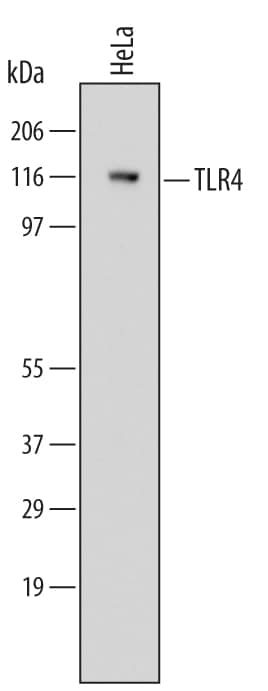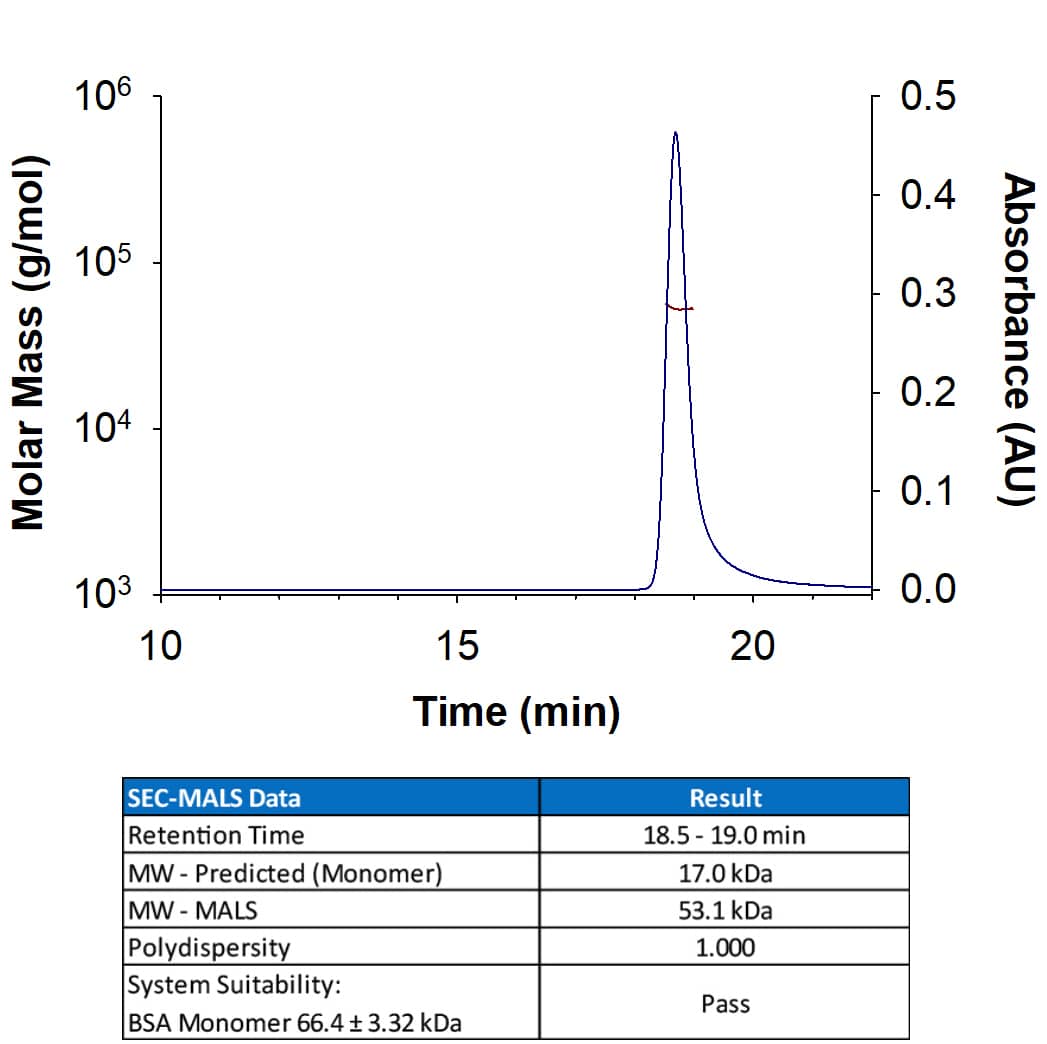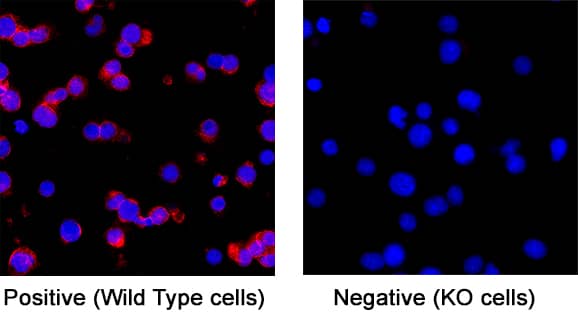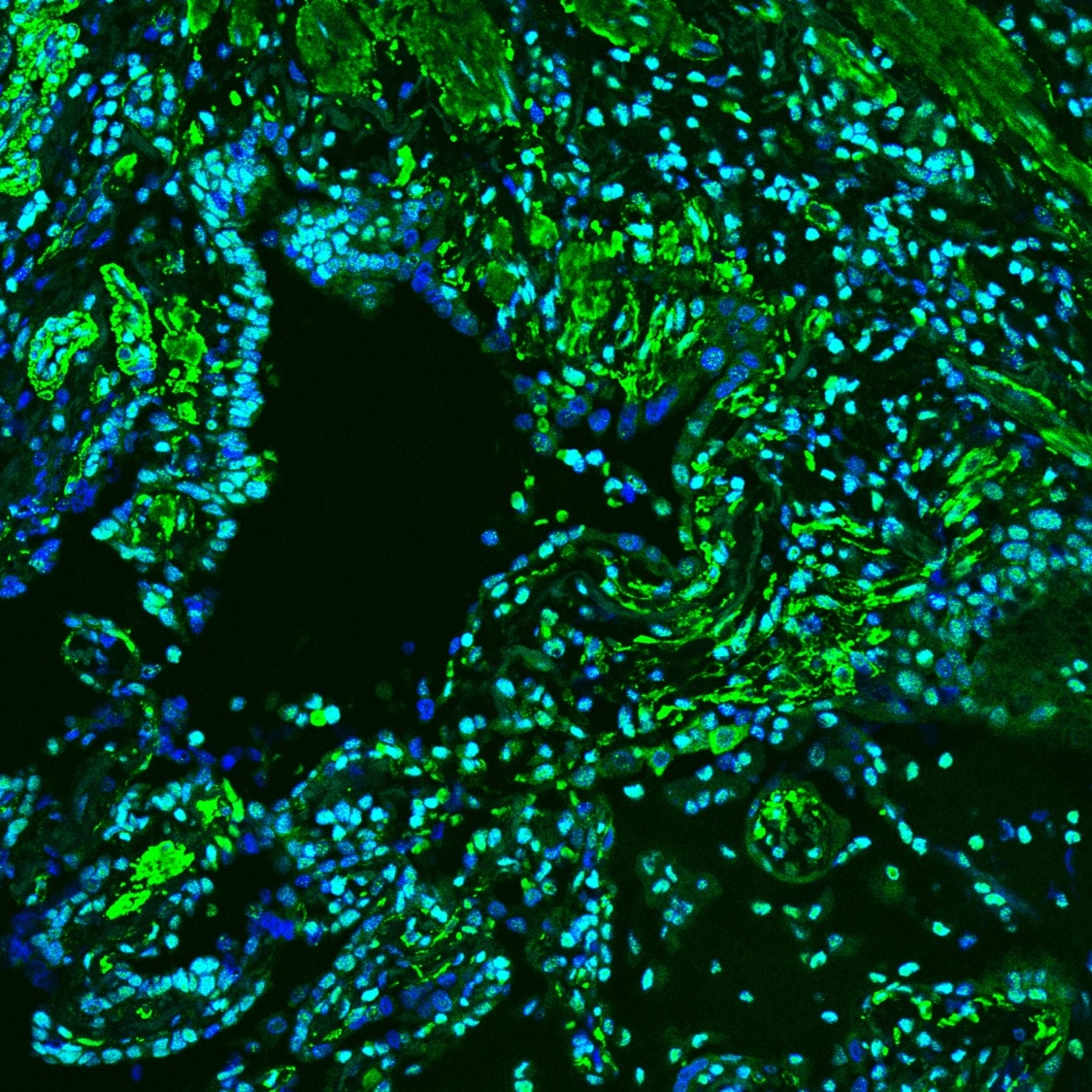Human HMGB1/HMG-1 Antibody Summary
Gly2-Glu215 (predicted)
Accession # P09429
Customers also Viewed
Applications
Please Note: Optimal dilutions should be determined by each laboratory for each application. General Protocols are available in the Technical Information section on our website.
Scientific Data
 View Larger
View Larger
Detection of Human HMGB1/HMG‑1 by Western Blot. Western blot shows lysates of HepG2 human hepatocellular carcinoma cell line, Jurkat human acute T cell leukemia cell line, and HEK293 human embryonic kidney cell line. PVDF membrane was probed with 0.05 µg/mL of Mouse Anti-Human HMGB1/HMG-1 Monoclonal Antibody (Catalog # MAB1690) followed by HRP-conjugated Anti-Mouse IgG Secondary Antibody (Catalog # HAF018). A specific band was detected for HMGB1/HMG-1 at approximately 26 kDa (as indicated). This experiment was conducted under reducing conditions and using Immunoblot Buffer Group 1.
 View Larger
View Larger
Detection of HMGB1/HMG‑1-regulated Genes by Chromatin Immunoprecipitation. HepG2 human hepatocellular carcinoma cell line was fixed using formaldehyde, resuspended in lysis buffer, and sonicated to shear chromatin. HMGB1/HMG-1/DNA complexes were immunoprecipitated using 5 µg Mouse Anti-Human HMGB1/HMG-1 PE-conjugated Monoclonal Antibody (Catalog # MAB1690) or control antibody (Catalog # MAB004) for 15 minutes in an ultrasonic bath, followed by Biotinylated Anti-Mouse IgG Secondary Antibody (Catalog # BAF007). Immunocomplexes were captured using 50 µL of MagCellect Streptavidin Ferrofluid (Catalog # MAG999) and DNA was purified using chelating resin solution. TheAFPpromoter was detected by standard PCR.
 View Larger
View Larger
Detection of HMGB1 in HCT‑116 Human Cell Line by Flow Cytometry. HCT-116 human colorectal carcinoma cell line was stained with Mouse Anti-Human HMGB1/HMG-1 Monoclonal Antibody (Catalog # MAB1690, filled histogram) or isotype control antibody (Catalog # MAB0041, open histogram), followed by Phycoerythrin-conjugated Anti-Mouse IgG F(ab')2Secondary Antibody (Catalog # F0102B). To facilitate intracellular staining, cells were fixed with Flow Cytometry Fixation Buffer (Catalog # FC004) and permeabilized with Flow Cytometry Permeabilization/Wash Buffer I (Catalog # FC005). View our protocol for Staining Intracellular Molecules.
 View Larger
View Larger
HMGB1/HMG‑1 in CCD‑18Co Human Cell Line. HMGB1/HMG-1 was detected in immersion fixed CCD-18Co human colonic fibroblast cell line using Mouse Anti-Human HMGB1/HMG-1 Monoclonal Antibody (Catalog # MAB1690) at 10 µg/mL for 3 hours at room temperature. Cells were stained using the NorthernLights™ 557-conjugated Anti-Mouse IgG Secondary Antibody (red, upper panel; Catalog # NL007) and counterstained with DAPI (blue, lower panel). Specific staining was localized to nuclei. View our protocol for Fluorescent ICC Staining of Cells on Coverslips.
 View Larger
View Larger
HMGB1/HMG-1 in Human Breast Cancer Tissue. HMGB1/HMG-1 was detected in immersion fixed paraffin-embedded sections of human breast cancer tissue using Mouse Anti-Human HMGB1/HMG-1 Monoclonal Antibody (Catalog # MAB1690) at 5 µg/mL overnight at 4 °C. Before incubation with the primary antibody, tissue was subjected to heat-induced epitope retrieval using Antigen Retrieval Reagent-Basic (Catalog # CTS013). Tissue was stained using the Anti-Mouse IgG VisUCyte™ HRP Polymer Antibody (brown; Catalog # VC001) and counterstained with hematoxylin (blue). Specific staining was localized to cell nuclei. View our protocol for IHC Staining with VisUCyte HRP Polymer Detection Reagents.
 View Larger
View Larger
Detection of Rat HMGB1/HMG-1 by Western Blot The effect of corticosterone on high-mobility group box-1 (HMGB1) release in primary cultured cortical astrocytes. (A) Increasing concentrations of corticosterone induced HMGB1 release from astrocytes. Cells were treated with the indicated concentrations of corticosterone for 24 h, and the amount of HMGB1 in the media was analyzed by Western blotting. Representative blots are shown (HMGB1: 30 kDa). The data are expressed as the mean ± SEM. * p < 0.05, ** p < 0.01 vs. basal (concentration “0”) (Dunnett’s test; n = 7–15). (B) Astrocytes were treated with 1 μM corticosterone for the indicated periods of time and the amount of HMGB1 in the media was analyzed by Western blotting. Representative blots are shown (HMGB1: 30 kDa). The data are expressed as the mean ± SEM. * p < 0.05, ** p < 0.01 vs. basal (time “0”) (Dunnett’s test; n = 3–15). (C) Astrocytes were treated with 1 μM corticosterone for 24 h, and media concentrations of HMGB1 were analyzed by ELISA. The data are expressed as the mean ± SEM. * p < 0.05 vs. vehicle (t-test; n = 5). Image collected and cropped by CiteAb from the following publication (https://pubmed.ncbi.nlm.nih.gov/32344830), licensed under a CC-BY license. Not internally tested by R&D Systems.
 View Larger
View Larger
Detection of Rat HMGB1/HMG-1 by Western Blot The effect of corticosterone on high-mobility group box-1 (HMGB1) release in primary cultured cortical astrocytes. (A) Increasing concentrations of corticosterone induced HMGB1 release from astrocytes. Cells were treated with the indicated concentrations of corticosterone for 24 h, and the amount of HMGB1 in the media was analyzed by Western blotting. Representative blots are shown (HMGB1: 30 kDa). The data are expressed as the mean ± SEM. * p < 0.05, ** p < 0.01 vs. basal (concentration “0”) (Dunnett’s test; n = 7–15). (B) Astrocytes were treated with 1 μM corticosterone for the indicated periods of time and the amount of HMGB1 in the media was analyzed by Western blotting. Representative blots are shown (HMGB1: 30 kDa). The data are expressed as the mean ± SEM. * p < 0.05, ** p < 0.01 vs. basal (time “0”) (Dunnett’s test; n = 3–15). (C) Astrocytes were treated with 1 μM corticosterone for 24 h, and media concentrations of HMGB1 were analyzed by ELISA. The data are expressed as the mean ± SEM. * p < 0.05 vs. vehicle (t-test; n = 5). Image collected and cropped by CiteAb from the following publication (https://pubmed.ncbi.nlm.nih.gov/32344830), licensed under a CC-BY license. Not internally tested by R&D Systems.
 View Larger
View Larger
Detection of Human HMGB1/HMG-1 by Immunohistochemistry RAGE and HMGB1 are expressed in myofibroblasts of endarterectomised chronic thromboembolic tissues of CTEPH patients.One representative patient is shown (12 out of 15 patients (80%) displayed analogous staining patterns. Photograph showing the macroscopic aspect of a representative PEA specimen (A). Scale bar: 6 cm. Immunohistochemical expression of RAGE (B, scale bar: 20 µm), HMGB1 (C), vimentin (D), alpha-smooth muscle actin (E) and CD34 (F) on adjacent tissue sections of the PEA specimen shown in (A). Scale bar: 40 µm. RAGE receptor for advanced glycation endproducts, HMGB1 high mobility group box 1, CTEPH chronic thromboembolic pulmonary hypertension, PEA pulmonary endarterectomy. Image collected and cropped by CiteAb from the following publication (https://dx.plos.org/10.1371/journal.pone.0106440), licensed under a CC-BY license. Not internally tested by R&D Systems.
Preparation and Storage
- 12 months from date of receipt, -20 to -70 °C as supplied.
- 1 month, 2 to 8 °C under sterile conditions after reconstitution.
- 6 months, -20 to -70 °C under sterile conditions after reconstitution.
Background: HMGB1/HMG-1
Human High-mobility group box 1 protein (HMGB1), previously known as HMG-1 or amphoterin, is a member of the high mobility group box family of non-histone chromosomal proteins (1‑3). Human HMGB1 is expressed as a 30 kDa, 215 amino acid (aa) single chain polypeptide containing three domains: two N-terminal globular, 70 aa positively charged DNA-binding domains (HMG boxes A and B), and a negatively charged 30 aa C-terminal region that contains only Asp and Glu (4, 5). Residues 27‑43 and 178‑184 contain a NLS. Posttranslational modifications of the molecule have been reported, with acetylation occurring on as many as 17 lysine residues (6). HMGB1 is expressed at high levels in almost all cells (2, 4). It was originally discovered as a nuclear protein that could bend DNA. Such bending stabilizes nucleosome formation and regulates the expression of select genes upon recruitment by DNA binding proteins (1, 7, 8). It is now known that HMGB1 can also act extracellularly, both as an inflammatory mediator that promotes monocyte migration and cytokine secretion, and as a mediator of T cell-dendritic cell interaction (1, 4, 7, 9, 10). The cytokine activity of HBMG1 is restricted to the HMG B box, (3) while the A box is associated with the helix-loop-helix domain of transcription factors (11). HMBG1 is released in response to cell death and as a secretion product. Although HMBG-1 does not possess a classic signal sequence, it appears to be secreted as an acetylated form via secretory endolysosome exocytosis (6, 12). Once secreted, HMGB1 transduces cellular signals through its high affinity receptor, RAGE and, possibly, TLR2 and TLR4 (1, 3, 4). Human HMGB1 is 100% aa identical to canine HMGB1 and 99% aa identical to mouse, rat, bovine and porcine HMGB1, respectively.
- Lotze, M.T. and K.J. Tracey (2005) Nat. Rev. Immunol. 5:331.
- Yang, H. et al. (2005) J. Leukoc. Biol. 78:1.
- Dumitriu, I.E. et al. (2005) Trends Immunol. 26:381.
- Degryse, B. and M. de Virgilio (2003) FEBS Lett. 553:11.
- Wen, L. et al. (1989) Nucleic Acids Res. 17:1197.
- Bonaldi, T. et al. (2003) EMBO J. 22:5551.
- Muller, S. et al. (2001) EMBO J. 20:4337.
- Bustin, M. (1999) Mol. Cell. Biol. 19:5237.
- Wang, H. et al. (1999) Science. 285:248.
- Dimitriu, I.E. et al. (2005) J. Immunol. 174:7506.
- Najima, Y. et al. (2005) J. Biol. Chem. 280:27523.
- Gardella, S. et al. (2002) EMBO Rep. 3:995.
Product Datasheets
Citations for Human HMGB1/HMG-1 Antibody
R&D Systems personnel manually curate a database that contains references using R&D Systems products. The data collected includes not only links to publications in PubMed, but also provides information about sample types, species, and experimental conditions.
34
Citations: Showing 1 - 10
Filter your results:
Filter by:
-
Damage-Associated Molecular Pattern and Fetal Membrane Vascular Injury and Collagen Disorganization in Lipopolysaccharide-Induced Intra-amniotic Inflammation in Fetal Sheep
Authors: Regan JK, Kannan PS, Kemp MW et al.
Reprod Sci.
-
Inhibition of HMGB1 suppresses inflammation and catabolism in temporomandibular joint osteoarthritis via NF-kappa B signaling pathway
Authors: Yan Yan Li, Ya Ping Feng, Li Liu, Jin Ke, Xing Long
European Journal of Histochemistry
-
Activated protein C inhibits LPS-mediated acetylation and secretion of HMGB1 in endothelial cells
Authors: Cai X, Biswas I, Panicker SR et al.
J. Thromb. Haemost.
-
Hmgb1 Silencing in the Amygdala Inhibits Pain-Related Behaviors in a Rat Model of Neuropathic Pain
Authors: Presto P, Ji G, Ponomareva O et al.
International Journal of Molecular Sciences
-
Repeated Social Defeat Stress Induces HMGB1 Nuclear Export in Prefrontal Neurons, Leading to Social Avoidance in Mice
Authors: Kitaoka, S;Tomohiro, A;Ukeshima, S;Liu, K;Wake, H;Kimura, S;Yamamoto, Y;Nishibori, M;Furuyashiki, T;
Cells
Species: Mouse
Sample Types: Whole Tissue
Applications: Immunohistochemistry -
MLKL Regulates Rapid Cell Death-independent HMGB1 Release in RSV Infected Airway Epithelial Cells
Authors: Jennifer Simpson, Kirsten M. Spann, Simon Phipps
Frontiers in Cell and Developmental Biology
Species: Human
Sample Types: Whole Cells
Applications: Immunocytochemistry -
Anti-HMGB1 antibody is a potential characteristic autoantibody for Sj�gren's syndrome
Authors: M Chen, Y Zhou, M Xue, R Zhu, L Jing, L Lin, C He, Y Qin
Scientific Reports, 2022-04-11;12(1):6020.
Species: Human
Sample Types: Serum
Applications: ELISA -
ATG 4B Serves a Crucial Role in RCE-4-Induced Inhibition of the Bcl-2-Beclin 1 Complex in Cervical Cancer Ca Ski Cells
Authors: FF You, J Zhang, F Cheng, K Zou, XQ Zhang, JF Chen
International Journal of Molecular Sciences, 2021-11-14;22(22):.
Species: Human
Sample Types: Cell Lysates
Applications: Immunoprecipitation -
Corticosterone Induces HMGB1 Release in Primary Cultured Rat Cortical Astrocytes: Involvement of Pannexin-1 and P2X7 Receptor-Dependent Mechanisms
Authors: K Hisaoka-Na, H Azuma, F Ishikawa, Y Nakamura, D Wang, K Liu, H Wake, M Nishibori, Y Nakata, N Morioka
Cells, 2020-04-25;9(5):.
Species: Rat
Sample Types: Cell Lysates
Applications: Western Blot -
Entamoeba histolytica stimulates the alarmin molecule HMGB1 from macrophages to amplify innate host defenses
Authors: S Begum, F Moreau, A Leon Coria, K Chadee
Mucosal Immunol, 2019-11-26;0(0):.
Species: Human
Sample Types: Cell Lysates
Applications: Western Blot -
Lack of IL-17 Receptor A signaling aggravates lymphoproliferation in C57BL/6 lpr mice
Authors: OBJ Corneth, F Schaper, F Luk, PS Asmawidjaj, AMC Mus, G Horst, P Heeringa, RW Hendriks, J Westra, E Lubberts
Sci Rep, 2019-03-11;9(1):4032.
Species: Human
Sample Types: Recombinant Protein
Applications: ELISA Standard -
Placental inflammation by HMGB1 activation of TLR4 at the syncytium
Authors: Line H. Tangerås, Gabriela B. Silva, Guro S. Stødle, Lobke M. Gierman, Bente Skei, Karin Collett et al.
Placenta
-
Cross-reactivity of anti-HMGB1 antibodies for HMGB2
Authors: Jessica E. Davies, Bonita H.R. Apta, Matthew T. Harper
Journal of Immunological Methods
-
Minocycline Attenuates High Mobility Group Box 1 Translocation, Microglial Activation, and Thalamic Neurodegeneration after Traumatic Brain Injury in Post-Natal Day 17 Rats
Authors: Dennis W. Simon, Rajesh K. Aneja, Henry Alexander, Michael J. Bell, Hülya Bayır, Patrick M. Kochanek et al.
Journal of Neurotrauma
-
Anti-high mobility group box-1 (HMGB1) antibody attenuates delayed cerebral vasospasm and brain injury after subarachnoid hemorrhage in rats
Sci Rep, 2016-11-24;6(0):37755.
Species: Rat
Sample Types: Whole Tissue
Applications: IHC-P -
Poly(ADP-Ribose) Polymerase 1-Sirtuin 1 Functional Interplay Regulates LPS-Mediated High Mobility Group Box 1 Secretion
Authors: Thomas D. Walko, Valentina Di Caro, Jon Piganelli, Timothy R. Billiar, Robert S. B. Clark, Rajesh K. Aneja
Molecular Medicine
-
Implant of Polymer Containing Pentacyclic Triterpenes from Eugenia punicifolia Inhibits Inflammation and Activates Skeletal Muscle Remodeling
Authors: Paulo Emílio C. Leite, Katia G. Lima-Araújo, Guilherme R. França, Jussara Lagrota-Candido, Wilson C. Santos, Thereza Quirico-Santos
Archivum Immunologiae et Therapiae Experimentalis
-
Local and systemic RAGE axis changes in pulmonary hypertension: CTEPH and iPAH.
Authors: Moser B, Megerle A, Bekos C, Janik S, Szerafin T, Birner P, Schiefer A, Mildner M, Lang I, Skoro-Sajer N, Sadushi-Kolici R, Taghavi S, Klepetko W, Ankersmit H
PLoS ONE, 2014-09-04;9(9):e106440.
Species: Human
Sample Types: Whole Tissue
Applications: IHC -
Expression of RAGE and HMGB1 in thymic epithelial tumors, thymic hyperplasia and regular thymic morphology.
Authors: Moser B, Janik S, Schiefer A, Mullauer L, Bekos C, Scharrer A, Mildner M, Renyi-Vamos F, Klepetko W, Ankersmit H
PLoS ONE, 2014-04-04;9(4):e94118.
Species: Human
Sample Types: Whole Tissue
Applications: IHC-P -
A dual-role of Gu-4 in suppressing HMGB1 secretion and blocking HMGB1 pro-inflammatory activity during inflammation.
Authors: Zhou H, Ji X, Wu Y, Xuan J, Qi Z, Shen L, Lan L, Li Q, Yin Z, Li Z, Zhao Z
PLoS ONE, 2014-03-06;9(3):e89634.
Species: Mouse
Sample Types: Whole Cells
Applications: ICC -
IL-1alpha released from damaged epithelial cells is sufficient and essential to trigger inflammatory responses in human lung fibroblasts.
Authors: Suwara M, Green N, Borthwick L, Mann J, Mayer-Barber K, Barron L, Corris P, Farrow S, Wynn T, Fisher A, Mann D
Mucosal Immunol, 2013-10-30;7(3):684-93.
Species: Human
Sample Types: Cell Culture Supernates
Applications: ELISA Development -
Sputum biomarkers and the prediction of clinical outcomes in patients with cystic fibrosis.
Authors: Liou T, Adler F, Keogh R, Li Y, Jensen J, Walsh W, Packer K, Clark T, Carveth H, Chen J, Rogers S, Lane C, Moore J, Sturrock A, Paine R, Cox D, Hoidal J
PLoS ONE, 2012-08-10;7(8):e42748.
Species: Human
Sample Types: Sputum
Applications: ELISA Development -
Human Papillomavirus Type 8 Interferes with a Novel C/EBPβ-Mediated Mechanism of Keratinocyte CCL20 Chemokine Expression and Langerhans Cell Migration.
Authors: Sperling T, Oldak M, Walch-Ruckheim B, Wickenhauser C, Doorbar J, Pfister H, Malejczyk M, Majewski S, Keates AC, Smola S
PLoS Pathog., 2012-07-26;8(7):e1002833.
Species: Human
Sample Types: Cell Lysates
Applications: Western Blot -
Defective expression and function of the leukocyte associated Ig-like receptor 1 in B lymphocytes from systemic lupus erythematosus patients.
Authors: Colombo B, Canevali P, Magnani O, Rossi E, Puppo F, Zocchi M, Poggi A
PLoS ONE, 2012-02-15;7(2):e31903.
Species: Human
Sample Types: Whole Cells
Applications: ICC -
Protection by 20-5,14-HEDGE Against Surgically Induced Ischemia Reperfusion Lung Injury in Rats
Authors: Irshad Ali, Stephanie Gruenloh, Ying Gao, Anne Clough, John R. Falck, Meetha Medhora et al.
The Annals of Thoracic Surgery
-
Measles virus causes immunogenic cell death in human melanoma.
Authors: Donnelly, O G, Errington-Mais, F, Steele, L, Hadac, E, Jennings, V, Scott, K, Peach, H, Phillips, R M, Bond, J, Pandha, H, Harrington, K, Vile, R, Russell, S, Selby, P, Melcher, A A
Gene Ther, 2011-12-15;20(1):7-15.
Species: Human
Sample Types: Cell Culture Supernates
Applications: Western Blot -
Fecal HMGB1 is a novel marker of intestinal mucosal inflammation in pediatric inflammatory bowel disease.
Authors: Vitali R, Stronati L, Negroni A
Am. J. Gastroenterol., 2011-07-26;106(11):2029-40.
Species: Human
Sample Types: Feces
Applications: Western Blot -
Ethyl pyruvate decreases HMGB1 release and ameliorates murine colitis.
Authors: Dave SH, Tilstra JS, Matsuoka K, Li F, DeMarco RA, Beer-Stolz D, Sepulveda AR, Fink MP, Lotze MT, Plevy SE
J. Leukoc. Biol., 2009-05-19;86(3):633-43.
Species: Mouse
Sample Types: Feces
Applications: ELISA Development -
Functional dissection of an IFN-alpha/beta receptor 1 promoter variant that confers higher risk to chronic hepatitis B virus infection.
Authors: Zhou J, Huang JD, Poon VK, Chen DQ, Chan CC, Ng F, Guan XY, Watt RM, Lu L, Yuen KY, Zheng BJ
J. Hepatol., 2009-05-03;51(2):322-32.
Species: Human
Sample Types: Cell Lysates
Applications: Western Blot -
E-selectin regulates gene expression in metastatic colorectal carcinoma cells and enhances HMGB1 release.
Authors: Aychek T, Miller K, Sagi-Assif O, Levy-Nissenbaum O, Israeli-Amit M, Pasmanik-Chor M, Jacob-Hirsch J, Amariglio N, Rechavi G, Witz IP
Int. J. Cancer, 2008-10-15;123(8):1741-50.
Species: Human
Sample Types: Cell Culture Supernates, Cell Lysates, Whole Cells
Applications: ICC, Immunodepletion, Western Blot -
Potential role of high-mobility group box 1 in cystic fibrosis airway disease.
Authors: Rowe SM, Jackson PL, Liu G, Hardison M, Livraghi A, Solomon GM, McQuaid DB, Noerager BD, Gaggar A, Clancy JP, O'Neal W, Sorscher EJ, Abraham E, Blalock JE
Am. J. Respir. Crit. Care Med., 2008-07-24;178(8):822-31.
Species: Human
Sample Types: Saliva, Whole Cells
Applications: Neutralization, Western Blot -
IL-1alpha and IL-1beta are endogenous mediators linking cell injury to the adaptive alloimmune response.
Authors: Rao DA, Tracey KJ, Pober JS
J. Immunol., 2007-11-15;179(10):6536-46.
Species: Human
Sample Types: Cell Lysates
Applications: Western Blot -
TLR4 enhances TGF-beta signaling and hepatic fibrosis.
Authors: Seki E, De Minicis S, Osterreicher CH, Kluwe J, Osawa Y, Brenner DA, Schwabe RF
Nat. Med., 2007-10-21;13(11):1324-32.
Species: Mouse
Sample Types: Cell Lysates
Applications: Western Blot -
Pivotal advance: inhibition of HMGB1 nuclear translocation as a mechanism for the anti-rheumatic effects of gold sodium thiomalate.
Authors: Zetterstrom CK, Jiang W, Wahamaa H, Ostberg T, Aveberger AC, Schierbeck H, Lotze MT, Andersson U, Pisetsky DS, Erlandsson Harris H
J. Leukoc. Biol., 2007-10-03;83(1):31-8.
Species: Mouse
Sample Types: Cell Culture Supernates
Applications: Western Blot
FAQs
No product specific FAQs exist for this product, however you may
View all Antibody FAQsReviews for Human HMGB1/HMG-1 Antibody
Average Rating: 4.3 (Based on 3 Reviews)
Have you used Human HMGB1/HMG-1 Antibody?
Submit a review and receive an Amazon gift card.
$25/€18/£15/$25CAN/¥75 Yuan/¥2500 Yen for a review with an image
$10/€7/£6/$10 CAD/¥70 Yuan/¥1110 Yen for a review without an image
Filter by:
I should say this is a good product. I purchased the small size, detected HMGB1 expression after TNF-a challenged. It is helpful.


















